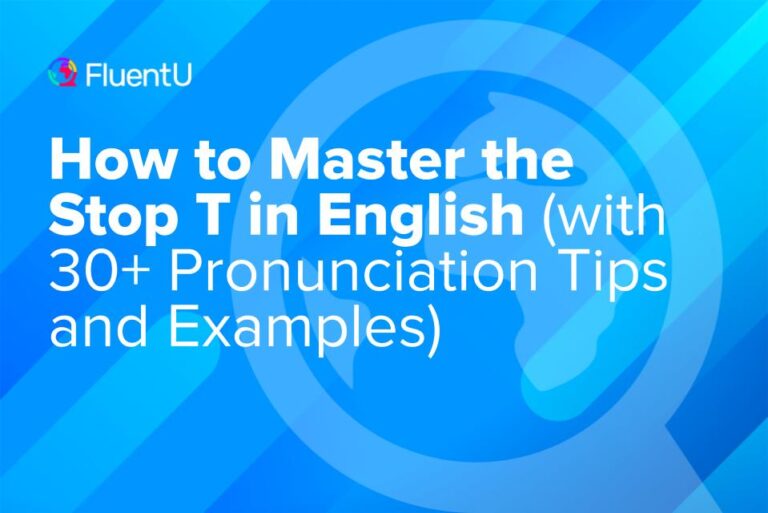5 T Pronunciation Rules for Clear American English

English can be a weird language.
Are you supposed to put an Oxford comma or not?
“Dough” and “rough” also have almost all of the same letters, but they don’t even rhyme.
Why are there so many irregular plural nouns, such as “goose” to “geese” and “child” to “children?”
Sometimes it just doesn’t make logical sense.
There is a method to the madness, though: English does have certain rules that work most of the time. This is true not only for grammar but also for pronunciation. Once you remember these rules, you can apply them repeatedly – there will still be exceptions, but they’re rare.
In this guide, we’ll be discussing the pronunciation rules for T – a seemingly simple letter in the English language that has multiple pronunciations. You’ll learn how to analyze which kind of T sound a word is likely to be using, even if it’s a completely new word for you!
Download: This blog post is available as a convenient and portable PDF that you can take anywhere. Click here to get a copy. (Download)
Kinds of T Sounds in English
There are several ways to pronounce the letter T in American English. These are the most widespread:
- A Standard T is the main pronunciation of T that you’ve learned
- Flap T – sounds like a D instead of a T
- Stop T – like a regular T but cut short because you don’t puff the air out
- Silent T – the T disappears when the word is said out loud
The kind of T sound that you should be using depends on where the T is located in the word or sentence.
As you probably already know from learning English, the spelling of a word can give you clues on how to pronounce it, but it’s not the whole answer. Even when two words both have a T, they’re not necessarily pronounced the same way.
T Pronunciation Rules
The four forms of T mentioned above are used fairly often in American English – you might even hear all of them together in one sentence.
Luckily, there’s a certain logic to pronouncing T. We can look at rules that clarify which T sound to use. These rules also apply to double T (TT). In the International Phonetic Alphabet, all sounds for T and TT have the same symbol: /t/.
Below, we’ve laid out a systematic way to figure out which kind of T sound you should be using (so you don’t have to check Google every time):
1. If T is at the start of a word, it’s a standard T.
The standard T is what you pronounce when you have to recite the alphabet. To pronounce the standard T, put your tongue behind your front teeth, then pull your tongue back while letting out a puff of air.
You’ll see the standard T most often at the start of a word.
Examples:
- Team
- Temperature
- Timid
- Tired
- Tolerant
- Torn
- Top
- Touch
- Turkey
- Type
2. If T is in ST, STR, CT, FT, LT, or PT, it’s a standard T.
These are called consonant clusters because they’re made up of two or three consonants. One exception is NT – if you see NT at the end of a word, then it might not be a standard T.
Examples:
- Adapt
- Asphalt
- Apt
- Drift
- Lift
- Plastic
- React
- Store
- Straight
- String
3. If T is at the start of a syllable, check if the syllable is stressed or unstressed.
It can get a bit trickier when T is in the middle of the word. Often, you’ll notice that T is at the start of a syllable, such as in words like “eternal” or “beautiful.”
Your next step is to check if the syllable is stressed or unstressed. Most English words only have one stressed syllable. This is emphasized and pronounced more slowly, with a higher pitch.
Is the syllable stressed?
If the T is at the start of a stressed syllable, then it’s a standard T. An example of this would be “eternal,” which we can break down into these syllables: “e-ter-nal.” The stressed syllable is “ter,” so the T here would be a standard T.
Examples:
- Antenna
- Atone
- Attorney
- Determined
- Maintain
- Maternal
- Partake
- Plantation
Is the syllable unstressed?
On the other hand, if the syllable is unstressed, then there are two more things that you have to check.
What comes after the T? If the T is followed by a vowel sound and a letter N, then it’s actually a stop T.
To pronounce a stop T, put your tongue in the same position as a standard T, but don’t puff out any air. In the middle of the word, it’ll sound like there’s a stop or a silent beat.
Examples:
- Kitten
- Britain
- Fountain
- Mountain
- Mitten
If the T is in between vowels, it’s a flap T.
If we look at the word “beautiful,” its syllables are “beau-ti-ful.” The stress is on the first syllable “beau,” so “ti” is an unstressed syllable. Since the T here is in between two vowels, we’ll use the flap T, so it’ll sound like “beaudiful.”
Examples:
- Getting
- Lottery
- Motor
- Voted
- Daughter
- Native
- Later
- Motto
- Pattern
If the T is in between R and a vowel, it’s also a flap T.
The five vowels in English are A, E, I, O, and U. Y can also be included here – it’s often pronounced as /ee/ or /e/, especially at the end of the word, so it can be considered a vowel sound.
A flap T sounds like a D. In this case, “thirty” would become “thirdy,” and “artist” would become “ardist.”
Examples:
- Artist
- Dirty
- Liberty
- Sporty
- Thirty
4. If the T is at the end of the word, look at the next word.
Aside from where the letter T is placed in the word, you might also have to look at the sentence as a whole.
Does the next word start with a vowel?
Then it’s a flap T.
Most of the time, a flap T is sandwiched in between two vowels – and that applies even when the next vowel is in another word.
In the sentence “What a catchy song!,” the T in “What” is in between two vowels. Since this would change into a flap T, the sentence would be pronounced as “Whadda catchy song!”
Examples:
- What a catchy song!
- I have a question about our proposal.
- There’s a cat on the roof.
- Some people say that life is a pursuit of meaning.
- The target is 45% for this quarter.
Does the next word start with a consonant?
On the other hand, if the next word starts with a consonant, it’s a stop T instead.
Examples:
- Take it down!
- That’s the polite thing to do.
- Here’s the budget sheet for our marketing campaign.
- My aunt loves drinking black tea.
- Sticking to a new habit can be really challenging.
- There’s a fun food market down the road.
Is the word at the end of a sentence, or does it stand on its own?
This would be a stop T too.
Here’s an example of a word where the pronunciation of T changes based on where it is in the sentence. Let’s take the word “what.” In the phrase, “What a catchy song!”, the T at the end is a flap T because it’s between vowels. However, when you say it on its own (“What?”), the T becomes a stop T instead.
Examples:
- What?
- Great!
- We should probably go inside – it’s getting hot.
- When are you going to visit?
- The lighting might be a bit too bright.
5. This is optional, but T can become silent when it’s part of NT in an unstressed syllable.
A lot of native English speakers remove T when they pronounce words such as “international,” “interview,” and “wanted,” all of which have the NT letter combination in an unstressed syllable. “Interview” becomes “inerview.” Unlike the stop T where there’s a beat, the T disappears completely from these words, as if it was never there in the first place.
This isn’t considered an official rule, but it can give your accent a certain twang that native speakers have!
Examples:
- Counter
- International
- Interview
- Painting
- Maintenance
- Wanted
There are other words too where the T becomes silent, but you’ll have to remember these on a case-by-case basis. Some of these words are also foreign. Words such as “gourmet,” which are borrowed from French, have a silent T.
Examples:
- Ballet
- Castle
- Gourmet
- Listen
- Mortgage
- Rapport
- Rustle
- Soften
- Whistle
- Valet
Applying the T Pronunciation Rules
That might sound like a lot of rules, but it’s actually fast to apply them to different English phrases and sentences! Let’s test it out:
I’m pretty nervous because I have an interview tomorrow.
- Pretty – Flap T. Double T (TT) is considered a T sound, and it’s at the start of an unstressed syllable here (“pre-tty”). Y here is a vowel sound because it’s pronounced as /ee/. Since the TT is in between two vowel sounds, it’s a flap T (“pri-dee”).
- Interview – Silent T. It’s part of NT in an unstressed syllable (“inerview”).
- Tomorrow – Standard T. This is because T is at the start of the word.
That is a stunning photo of a fountain. I heard that the photographer only started learning last year.
- That is – Flap T. Since T is at the end of the word here (“that”), we have to look at the next word – in this case, “is” starts with a vowel. The T is then in between two vowels, even if they’re not in the same word.
- Stunning – Standard T. Remember the T rule about consonant clusters? The T here is part of the consonant cluster “ST,” meaning we pronounce it as a standard T.
- Photo – Flap T. “Photo” can be broken down into the syllables “pho-to.” T is in between vowels and at the start of an unstressed syllable, so we get a flap T, almost as if we were saying “phodo.”
- Fountain – Stop T. The T here is at the start of an unstressed syllable too (“foun-tain”). However, it’s followed by a vowel sound and the letter N.
- Photographer – Standard T. Even though the T in “photo” is a flap T, it’s not the same thing here. Notice that the T in “photographer” is in a stressed syllable (“pho-to-gra-pher”). This means we use a standard T instead.
- Started – Flap T (“starded”). T is in between R and a vowel in an unstressed syllable.
- Last year – Stop T. The T is at the end of the word (“last”), and the next word (“year”) starts with a consonant.
They might have gotten lost. It’s a huge city!
- Lost – Stop T because the T is at the end of the sentence.
- City – Flap T (“cid-ee”). Y is a vowel sound here (/ee/), meaning that T is in between two vowel sounds.
Conclusion
Many English learners spend a lot of time trying to pronounce T correctly, along with other sounds such as L, V, and R. After all, it’s not obvious at first that you can pronounce T in several ways.
While the rules of English will never be as exact as math, knowing these T pronunciation rules can make it clear why native speakers can sometimes say things differently – for example, changing T to D in some words (now you know that’s the flap T)!







